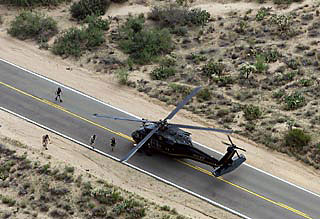Tucson Citizen
Monday, September 13, 2004
Black Hawks enlisted to protect the border

|
| A Black Hawk helicopter lands on a public highway so its crew can pursue
illegal immigrants near Three Points. The Black Hawk, long a staple of
Army air operations, now is a cog for the Customs Service, whose officers
are participating in joint air operations across southern Arizona with
the Border Patrol, its sister agency. |
U.S. Immigration and Customs Enforcement is using the
helicopters in joint operations with the Border Patrol.
The Associated Press
THREE POINTS - Airborne for just a few minutes, the Black Hawk helicopter's
crew was already busy, circling over nearly 20 illegal immigrants trying
to hide beneath mesquite trees along a desert wash.
After landing nearby, immigration agents jumped out to start rounding
up the mostly young men whose efforts to reach the U.S. interior and find
jobs had been nipped abruptly for now.
The large, reliable Black Hawk, long a staple of Army air operations,
now is a cog for U.S. Immigration and Customs Enforcement, whose officers
are participating in joint air operations across southern Arizona with
the Border Patrol, a sister agency.
They use the helicopter's day-or-night, all-weather ability to fly up
to 200 mph at altitudes as high as 12,000 feet and as low as treetop level,
helping guard and control the Arizona border. This day was typically busy
for the agents.
The agents deployed in washes southeast of Ryan Airfield, about 25 miles
west of Tucson, while the helicopter returned to the air, the pilot flying
low, looking for shadows in and around saguaros, paloverde and mesquite
trees and brush.
"After a while of looking at the branches out here, you can tell when
something doesn't look natural," said crew member Craig Davis.
One agent on the ground spotted a woman lying inside a small cave cut
along the edge of a wash. "Somebody is playing possum, or they're in distress,"
Davis said.
Moments later, the woman was on her feet, walking unaided and without
visible distress to join others in the apprehended group.
"Our biggest concern is saving lives," Davis said.
The Border Patrol agents on each ICE helicopter are emergency medical
technicians, able to provide emergency treatment in remote areas for migrants
suffering from heat exposure or other problems.
In less than two hours, the crew, joined by agents in other helicopters
and on the ground, would intercept more than 100 illegal immigrants in
several groups scattered over several miles of desert, all trying to make
their way north from Mexico.
They had paid or promised money to smugglers and had walked about 50
miles north from the border near Sasabe. Now they faced being sent back
south.
Apprehended migrants are turned over to Border Patrol agents on the
ground, taken to Tucson and checked for criminal records, prior apprehensions
or arrest warrants. They are then repatriated to their native countries,
most of the time back to Mexico.
Through September, those who volunteer will be flown to Mexico City
or Guadalajara deep in the Mexican interior. Others are dropped off at
the Mexican border.
The daily ICE helicopter patrols, flying some 10 to 12 hours a day,
concentrate largely on desert areas west and south of Tucson crisscrossed
by thousands of illegal immigrants. Those areas have been among the most
active crossing points in Arizona, the busiest illegal entry point along
the U.S.-Mexico border.
The air branch unit has 13 aircraft available, including five UH-60
Black Hawk helicopters capable of landing in the rugged southern Arizona
terrain.
As part of a larger Arizona border crackdown that officially ends Sept.
30, the air patrols are coordinating closely with Border Patrol efforts
to secure the border, catching illegal immigrants, helping seize drugs
and other contraband and saving lives.
At the same time, said Martin E. Vaughan Jr., field director of the
Tucson Air Branch of ICE's air and marine operations, "We try not to duplicate
what the Border Patrol is doing."
The unit's role has shifted, Vaughan said. Before, "Our mission was
pretty clear in terms of an anticontraband mission" focused primarily on
drug smuggling, he said. "Now we realize that any intruder could be a threat."
More than 6,700 illegal immigrants have been apprehended over nearly
1,500 flight hours between March 16, when the border crackdown began, and
the end of August.
And 11 months through the fiscal year, which ends Sept. 30, the air
operations have accounted for the capture of 8,282 illegal immigrants.
"We're pretty successful through the summer periods now," Vaughan said.
"As summer's starting to wind down, we're seeing the movement take place
that we anticipated.
"The seizures have reduced, the numbers of detainees are reducing and
other locations are seeing increases, at least outside the Tucson sector,"
which covers all but the extreme southwest corner of Arizona.
Vaughan said officials were holding strategic briefings to decide how
to respond as illegal immigrants shift from Arizona and whether to reallocate
the air resources elsewhere.
"We're discussing that now, analyzing the threat to determine what level
of activity is needed to mitigate the threat," Vaughan said.
